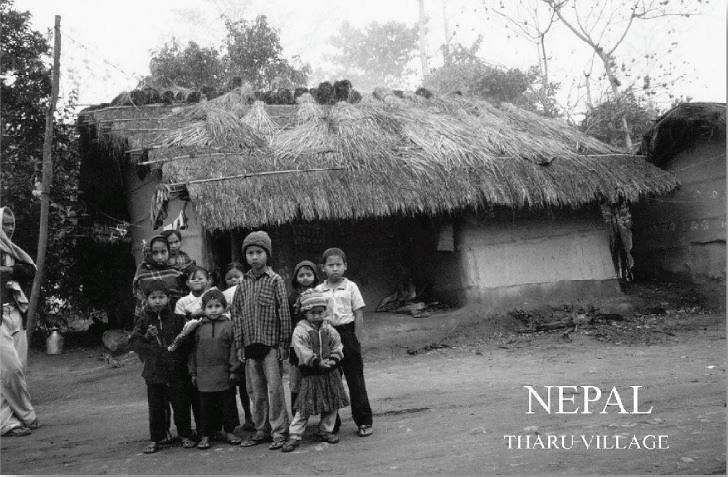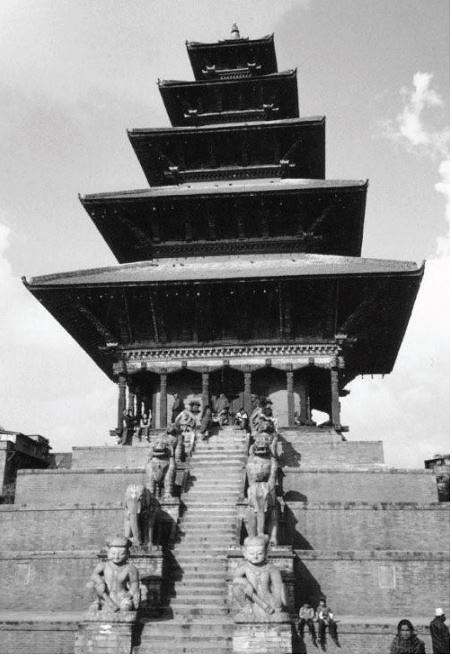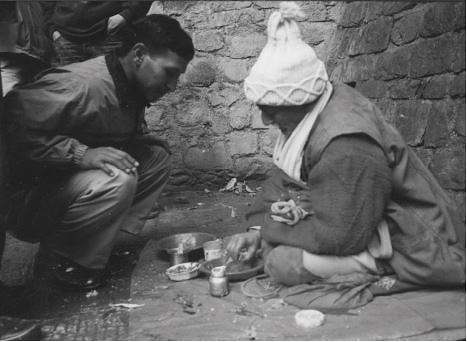
January 2004
The US State Department had an advisory against unessential travel to Nepal, due to the Maoist insurgency. We decided to travel with a group of Belgians, who had no such advice from their government. We notified the US Embassy in Nepal that two Americans were coming, and registered our names.
Nepal, which in 2008 became a federal democratic republic, was at the time a multiparty democracy based on a constitutional monarchy. The king was known to dissolve the Parliament at his pleasure. Nepal is a country made up of many ethnic groups with striking central Asian features. The majority live in Katmandu, the capital city. They are eager to learn the ways of the modern world. Signs for computer classes pop up in unexpected places. Many people speak English. There is even a Barnes and Noble bookstore in town.
Ancient kingdoms have left great legacies in Nepal. The Katmandu Valley is full of treasure troves in places such as Central Katmandu, Bungamati, Patan, and Bhaktapur. UNESCO has designated many of these as world heritage sites. Magnificent temples and royal palaces, guarded by ornate statues, cluster around an open public place in downtown Katmandu called Durbar Square, where festivals and celebrations take place.

Temple in Bhaktapur
The predominant religion is Hinduism. However, Nepal, as the birthplace of the founder of Buddhism, has developed a syncretic religious culture that combines many aspects of Hinduism and Buddhism. One such shared cult is that of the Kumari, the Living Goddess. The Kumari represents the Hindu goddess Taleju. But the girl who is said to incarnate the goddess is chosen from the Newar Buddhist community. She is revered as a Hindu and Buddhist deity, serving until the onset of puberty, at which time another child is chosen. A vast pantheon of gods and goddesses are worshipped in the country.
Our tour included a two-day excursion to Royal Chitwan National Park, which is in the jungle near Nepal’s southern border with India. Generally, roads are in poor condition. Nepalese clear and terrace hills to grow rice. Landslides are common when it rains. Already halfway to Chitwan, we found out that our road was closed due to a landslide, since it had rained the day before. We either had to return or take an alternate mountain road.
Our guide opted for the alternate road, but misestimated how long it would take to reach our destination. Thus, we missed the 7:30 pm national curfew, declared for all areas outside of the Katmandu Valley because of the Maoist insurgents. Soldiers in camouflage uniforms stopped our van and told us that we could not continue until 5 am. After much begging and waiting for permission from their commanders, we were able to continue. Past midnight, with only twelve kilometers left to go, we were stopped again and rerouted to a hotel outside of the park, since our lodge was in the middle of the jungle, a dangerous place to drive at night. We went to bed hungry and exhausted, but relieved to be safe.
Early in the morning we settled in our bungalows, but missed our first elephant safari, which had left at dawn. Instead we visited a Tharu village. Selim opted to sleep. The Tharu are jungle dwellers who have migrated from Gujarat in India. They are proud to have cured themselves of malaria using herbs from the jungle. On average each family has six to ten children, who are believed to be divine gifts. People marry very young. The Tharu we saw seemed content in their modest huts with thatched roofs, tending to their animals and daily chores. I was invited into one of the huts and was amazed at the orderliness of its interior, despite the number of children. The village was like something from a picture book, with a beautiful view of the Himalayas in the background.
We spent the rest of the day on elephant back tracking wildlife. Our guides knew every kind of excrement on the road and were able to identify which animals were nearby. We saw several rhinos and deer. The jungle excursion ended with a canoe trip to a crocodile farm.
Our return to Katmandu fell on a holy day when the Nepalese honor Sarawati, the goddess of wisdom. On this day children begin to read, young people marry, the faithful make a pilgrimage to a sacred site, and everyone celebrates the end of winter and the beginning of spring. On our way, we stopped to watch wedding preparations, ritual bathers, and cremations by the river.

Preparing for temple ritual
Devghat, an ancient holy site, is at the confluence of two sacred rivers, the Kali Gandaki and the Trisuli, which descend from the Himalayas and are major tributaries to the Ganges. Hindus, who come here for sacrificial rites or even to live out their final days, regard the site as religiously significant. Only Hindus may enter the shrines and temples. As this was a holy day, the faithful arrived by the thousands carrying elaborate offerings and sacrificial animals, such as goats and chickens. Ritual bathers cleansed themselves in holy waters; young boys sacrificed their hair and donned wool caps over their shaven heads. Amazed, Selim and I watched a big bull saunter into the temple, which we could not enter. People in white robes, worn by those in mourning, sat by the river watching the bodies of their loved ones burn. Cremation in holy waters protects the deceased from going to the underworld and speeds up reincarnation.
On our final day in Katmandu we visited Boudhanath, a cultural center for the Tibetan exile community in Nepal. The Great Stupa (Buddhist reliquary), shaped like a gigantic mandala and decorated with strings of fluttering prayer flags, sits in the center of this hilltop village. The all-seeing eyes of the Buddha painted over the stupa observe all four directions, while beneath them Buddhist pilgrims circumambulate clockwise, spinning prayer wheels. Even tourists must walk clockwise around the stupa, which is surrounded by shops specializing in Tibetan crafts. Tibetan carpets are the leading income generator for the exile community, many of whom work in this industry. Other ethnic groups specialize in a variety of crafts, including beautiful textiles, pottery, woodwork, and metalwork.
Nepalese cuisine, while distinct from Indian food, has been largely influenced by it. All local food tends to be spicy. Restaurants and hotels catering to tourists offer options for less spicy dishes. Lentils are a staple, and every variety — green, yellow, and red — appears on all menus. A typical plate has a mound of rice in the center with a choice of surrounding dishes. Locals tear a thin piece of flat bread, wrap it around some rice and lentils, and pop it into their mouths. They are very adept at eating this way without spilling. In this instance we did not follow the local custom. We ate only cooked dishes, abstained from raw salads, and did not eat any fruit we could not peal. We bought bottled water on all occasions.
We flew from Katmandu back to Delhi on Air India. Then we traced our way back to Brussels via Vienna on Austrian Airlines. The calm and order at Vienna airport was a welcome change from the crush of people in Delhi. Nor did I need to look for change to use the bathroom, as I always had in both India and Nepal. I spent the weekend in Brussels, where I had my ten rolls of film developed. I am still living with the images of this amazing trip. I have a panoramic photo of the bull on its way into the temple.
